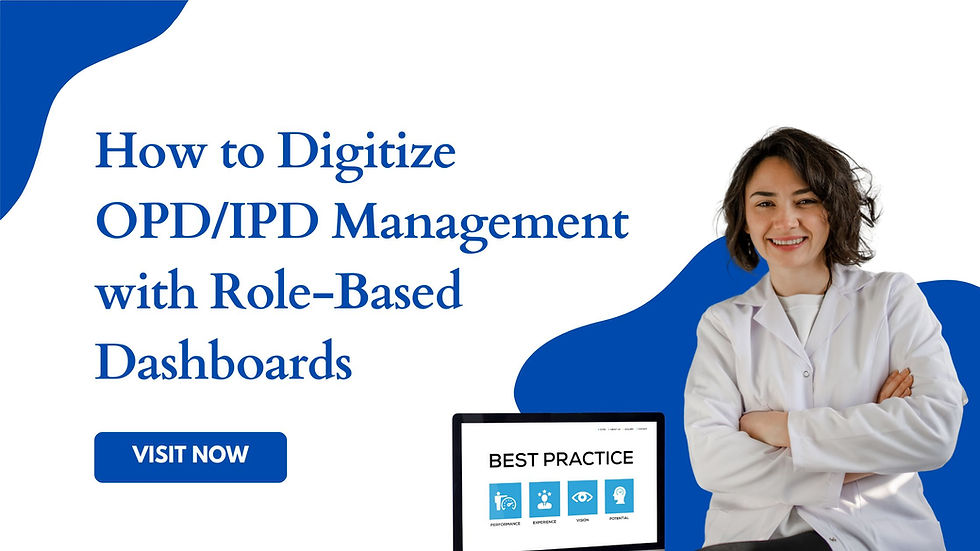How to Digitize OPD/IPD Management with Role-Based Dashboards
- Arobit Digital
- May 30
- 3 min read

The healthcare industry is evolving rapidly with the integration of technology. One critical area of improvement is the management of OPD (Outpatient Department) and IPD (Inpatient Department) services. Traditional paper-based or semi-digital systems often lead to inefficiencies, data errors, and poor patient experience.
Digitizing OPD/IPD management using role-based dashboards is a practical and scalable solution for hospitals, clinics, and healthcare institutions. This article explores the process, benefits, tips, and real-world implementation of such systems—especially focusing on how you can adopt it seamlessly with the help of expert healthcare IT partners.
What is OPD/IPD Management?
OPD (Outpatient Department) management refers to the handling of patients who visit a hospital or clinic for diagnosis or treatment but do not require an overnight stay. IPD (Inpatient Department) management involves patients who are admitted for one or more nights for treatment or observation.
Efficient OPD/IPD systems are vital to delivering timely care, managing staff workflows, and maintaining accurate records.
The Need for Digitization in OPD/IPD Management
Paper-based systems often cause:
Delayed appointments and long queues
Disorganized patient data
Inaccurate billing
Communication gaps between departments
Lack of role clarity among staff
Digitizing these processes ensures real-time data access, better decision-making, and enhanced patient satisfaction.
What are Role-Based Dashboards?
Role-based dashboards are personalized digital interfaces where each user—doctor, nurse, admin, billing staff, lab technician, or management—sees only the information relevant to their role.
For example:
Doctors see patient medical history, appointments, and treatment notes.
Nurses track medication schedules and patient vitals.
Billing staff manage payments and insurance claims.
Hospital administrators monitor department performance and resource usage.
These dashboards improve security, minimize data clutter, and optimize performance for each stakeholder.
Key Benefits of Role-Based Dashboards in OPD/IPD Management
Streamlined Patient Flow
Automated appointment booking
Digital queue management
Real-time patient status tracking
Better Coordination Among Staff
Role-specific alerts and reminders
Unified communication across departments
Enhanced Data Accuracy
Centralized EHR (Electronic Health Record) access
Reduction in manual errors
Data-Driven Decision Making
Analytics and reports for hospital management
Monitoring staff efficiency and patient outcomes
Improved Patient Satisfaction
Shorter waiting times
Transparent billing
Personalized care journey
How to Implement Digitized OPD/IPD Management
Here is a step-by-step approach to successful implementation:
1. Assess Your Current System
Identify inefficiencies and bottlenecks
Evaluate the level of digitization already in place
2. Choose the Right Software Partner
Look for providers with healthcare domain experience
Prioritize data security, compliance, and support
3. Define User Roles and Access Levels
Create role hierarchies (Doctor, Nurse, Receptionist, etc.)
Map responsibilities and required data access
4. Migrate and Clean Data
Digitize old records
Ensure accuracy and consistency
5. Train Your Staff
Conduct role-specific training sessions
Provide manuals and 24/7 tech support
6. Monitor & Optimize
Track performance KPIs
Collect feedback and make necessary adjustments
Tips for Smooth Transition to Role-Based OPD/IPD Management
Start small, scale gradually: Begin with one department or branch and then expand.
Keep it user-friendly: Choose a system with an intuitive interface.
Ensure mobile accessibility: Staff should be able to access dashboards via mobile or tablets.
Prioritize data security: Use encrypted systems and secure login protocols.
Regular updates and maintenance: Keep the software updated for best performance and security.
How Arobit Can Help You Digitize OPD/IPD Management
At Arobit, we specialize in delivering customized healthcare IT solutions tailored to your hospital or clinic’s specific needs.
Here's how we assist:
Tailored dashboard creation based on staff roles
Seamless integration with existing hospital systems
HIPAA and data privacy compliant platforms
On-site and remote training for smooth adoption
Ongoing support and enhancements to match your growth
Whether you're a small clinic or a multi-specialty hospital, our team can help you build a robust, efficient, and fully digitized OPD/IPD management system that scales with your operations.
FAQs
Q1. Is it expensive to digitize OPD/IPD management?
Not necessarily. Costs vary based on your needs. Modular systems allow you to start small and expand. In the long run, it saves time, reduces errors, and improves revenue management.
Q2. How long does it take to implement role-based dashboards?
Depending on your hospital's size and complexity, it could take anywhere from a few weeks to a couple of months for complete implementation.
Q3. Will my staff need technical knowledge to use these dashboards?
No. Dashboards are designed to be user-friendly. We also offer complete onboarding and training support.
Q4. Can I integrate this with existing EMR or billing systems?
Yes. Arobit offers integration-friendly platforms that can sync with your current systems.
Final Thoughts
Digitizing OPD/IPD management with role-based dashboards isn’t just a tech upgrade—it’s a strategic shift toward better healthcare delivery. It ensures your staff works more efficiently and your patients receive timely, coordinated care



Comments